Effects of Polypropylene Fiber on the Liquefaction Resistance of Saturated Sand in Ring Shear Tests
Abstract
1. Introduction
2. Materials and Methods
2.1. Materials
2.2. Ring Shear Apparatus
2.3. Test Procedure
2.4. Energy Approach
3. Results
3.1. Shear-Torque-Controlled (STC) Tests
3.2. Cyclic-Torque-Controlled (CTC) Tests
3.3. Stress Paths and the Collapsed Structure of Specimens
4. Discussion
5. Conclusions
- (1)
- The liquefaction resistance of fiber-reinforced sand is influenced by both the sand density and amount of fiber used in all the tests. The presence of fibers increases the shear strength and shearing time of saturated sand in STC tests. It also clearly increases the cycles required for liquefaction in CTC tests, and the number of cycles increases with the increasing sand density and fiber content. The stress paths show a similar trend for the same density specimen, while the pore pressure generation of fiber-reinforced specimens is slower than the unreinforced specimen.
- (2)
- The energy approach is used to evaluate the soil liquefaction resistance. In ring shear rests, the shear energy is dependent on the shear stress and shear displacement. The total shear energy increased with the increase of both sand density and fiber content. The shear energy mainly consumed from the shear failure was triggered to liquefaction or a final steady.
- (3)
- For two shearing methods, all the unreinforced loose specimens collapsed completely and the dense one collapsed partly after performing shearing tests; but the fiber-reinforced specimens still maintain structural stability. It is hence that the lateral failure of the sand induced by liquefaction can be limited or even prevented by means of mixing the fibers.
- (4)
- Fiber reinforcement might provide a three-dimensional structure among sand grains via interlinking, overlapping and crossing, and increase the stability microstructures, thereby requiring more energy to overcome the resistance during the shearing process. The test results demonstrated that the addition of fiber can be used as an available technology to enhance the anti-liquefaction ability of sand.
Author Contributions
Funding
Acknowledgments
Conflicts of Interest
References
- Audemard, F.A.; Gomez, J.C.; Tavera, H.J.; Orihuela, N. Soil liquefaction during the Arequipa Mw 8.4, 21 June 2001 earthquake, southern coastal Peru. Eng. Geol. 2005, 78, 237–255. [Google Scholar] [CrossRef]
- Papathanassiou, G.; Seggis, K.; Pavlides, S. Evaluating earthquake-induced liquefaction in the urban area of Larissa, Greece. Bull. Eng. Geol. Environ. 2011, 70, 79–88. [Google Scholar] [CrossRef]
- Kazama, M.; Kataoka, S.; Uzuoka, R. Volcanic mountain area disaster caused by the Iwate–Miyagi Nairiku Earthquake of 2008, Japan. Soils Found. 2012, 52, 168–184. [Google Scholar] [CrossRef]
- Bhattacharya, S.; Hyodo, M.; Goda, K.; Tazoh, T.; Taylor, C. Liquefaction of soil in the Tokyo Bay area from the 2011 Tohoku (Japan) earthquake. Soil Dyn. Earthq. Eng. 2011, 31, 1618–1628. [Google Scholar] [CrossRef]
- Orense, R.; Pender, M.; Wotherspoon, L. Analysis of Soil Liquefaction during the Recent Canterbury (New Zealand) Earthquakes. Geotech. Eng. J. SEAGS AGSSEA 2012, 43, 8–17. [Google Scholar]
- Gautam, D.; De Magistris, F.S.; Fabbrocino, G. Soil liquefaction in Kathmandu valley due to 25 April 2015 Gorkha, Nepal earthquake. Soil Dyn. Earthq. Eng. 2017, 97, 37–47. [Google Scholar] [CrossRef]
- Huang, Y.; Yu, M. Review of soil liquefaction characteristics during major earthquakes of the twenty-first century. Nat. Hazards 2013, 65, 2375–2384. [Google Scholar] [CrossRef]
- Huang, Y.; Bao, Y.; Zhang, M.; Liu, C.; Lu, P. Analysis of the mechanism of seabed liquefaction induced by waves and related seabed protection. Nat. Hazards 2015, 79, 1399–1408. [Google Scholar] [CrossRef]
- Sonmez, B.; Ulusay, R.; Sonmez, H. A study on the identification of liquefaction-induced failures on ground surface based on the data from the 1999 Kocaeli and Chi-Chi earthquakes. Eng. Geol. 2008, 97, 112–125. [Google Scholar] [CrossRef]
- Kanth, S.T.G.R.; Dash, S.K. Evaluation of seismic soil-liquefaction at Guwahati city. Environ. Earth Sci. 2010, 61, 355–368. [Google Scholar] [CrossRef]
- Shogaki, T.; Kaneda, K. Feasible method, utilizing density changes, for estimating in situ dynamic strength and deformation properties of sand samples. Soils Found. 2013, 53, 64–76. [Google Scholar] [CrossRef][Green Version]
- Su, D.; Ming, H.; Li, X. Effect of shaking strength on the seismic response of liquefiable level ground. Eng. Geol. 2013, 166, 262–271. [Google Scholar] [CrossRef]
- Karakan, E.; Eskişar, T.; Altun, S. The Liquefaction Behavior of Poorly Graded Sands Reinforced with Fibers. Adv. Civ. Eng. 2018, 2018, 4738628. [Google Scholar] [CrossRef]
- Amini, P.F.; Noorzad, R. Energy-based evaluation of liquefaction of fiber-reinforced sand using cyclic triaxial testing. Soil Dyn. Earthq. Eng. 2018, 104, 45–53. [Google Scholar] [CrossRef]
- Noorzad, R.; Amini, P.F. Liquefaction resistance of Babolsar sand reinforced with randomly distributed fibers under cyclic loading. Soil Dyn. Earthq. Eng. 2014, 66, 281–292. [Google Scholar] [CrossRef]
- Maheshwari, B.K.; Singh, H.P.; Saran, S. Effects of Reinforcement on Liquefaction Resistance of Solani Sand. J. Geotech. Geoenviron. Eng. 2012, 138, 831–840. [Google Scholar] [CrossRef]
- Ye, B.; Cheng, Z.R.; Liu, C.; Zhang, Y.D.; Lu, P. Liquefaction resistance of sand reinforced with randomly distributed polypropylene fibres. Geosynth. Int. 2017, 24, 625–636. [Google Scholar] [CrossRef]
- Ibraim, E.; Diambra, A.; Wood, D.M.; Russell, A. Static liquefaction of fibre reinforced sand under monotonic loading. Geotext. Geomembr. 2010, 28, 374–385. [Google Scholar] [CrossRef]
- Liu, J.; Wang, G.; Kamai, T.; Zhang, F.; Yang, J.; Shi, B. Static liquefaction behavior of saturated fiber-reinforced sand in undrained ring-shear tests. Geotext. Geomembr. 2011, 29, 462–471. [Google Scholar] [CrossRef]
- Seed, H.B.; Idriss, I.M. A Simplified procedure for evaluating soil liquefaction potential. J. Soil Mech. Found. Div. 1971, 97, 1249–1273. [Google Scholar]
- Nemat-Nasser, S.; Shokooh, A. A unified approach to densification and liquefaction of cohesionless sand in cyclic shearing. Can. Geotech. J. 1979, 16, 659–678. [Google Scholar] [CrossRef]
- Davis, R.O.; Berrill, J.B. Energy dissipation and seismic liquefaction in sands. Earthq. Eng. Struct. Dyn. 1982, 10, 59–68. [Google Scholar]
- Towhata, I.; Ishihara, K. Shear work and pore water pressure in undrained shear. Soils Found. 1985, 25, 73–84. [Google Scholar] [CrossRef]
- Cao, Y.L.; He, G.N.; Law, K.T. An energy approach for assessing seismic liquefaction potential. Can. Geotech. J. 1990, 27, 320–329. [Google Scholar]
- Figueroa, J.L.; Saada, A.S.; Liang, L.; Dahisaria, N.M. Evaluation of Soil Liquefaction by Energy Principles. J. Geotech. Eng. 1994, 120, 1554–1569. [Google Scholar] [CrossRef]
- Dief, H.M.; Figueroa, J.L. Evaluation of soil liquefaction by energy principles through centrifuge tests. In Proceedings of the ISRM International Symposium, Melbourne, Australia, 19–24 November 2000. [Google Scholar]
- Bishop, A.W.; Green, G.E.; Garga, V.K.; Andresen, A.; Brown, J.D. A New Ring Shear Apparatus and Its Application to the Measurement of Residual Strength. Géotechnique 1971, 21, 273–328. [Google Scholar] [CrossRef]
- Gibo, S. Ring Shear Apparatus for Measuring Residual Strengths and its Measurement Accuracy. J. Jpn. Landslide Soc. 2011, 31, 24–30_1. [Google Scholar] [CrossRef][Green Version]
- Okada, Y.; Sassa, K.; Fukuoka, H. Comparison of Shear Behaviour of sandy soils by Ring-Shear Test with Conventional Shear Tests. In Proceedings of the IUFRO Division 8 Conference on Environmental Forest Science, Kyoto, Japan, 19–23 October 1998; Springer: Berlin/Heidelberg, Germany, 1998; Volume 54, pp. 623–632. [Google Scholar]
- Okada, Y.; Sassa, K.; Fukuoka, H. Excess pore pressure and grain crushing of sands by means of undrained and naturally drained ring-shear tests. Eng. Geol. 2004, 75, 325–343. [Google Scholar] [CrossRef]
- Olson, S.M.; Sadrekarimi, A. Particle damage observed in ring shear tests on sands. Can. Geotech. J. 2010, 47, 497–515. [Google Scholar]
- Hejazi, S.M.; Sheikhzadeh, M.; Abtahi, S.M.; Zadhoush, A. A simple review of soil reinforcement by using natural and synthetic fibers. Constr. Build. Mater. 2012, 30, 100–116. [Google Scholar] [CrossRef]
- Sassa, K. A new intelligent-type dynamic-loading ring-shear apparatus. Landslide News 1997, 10, 33. [Google Scholar]
- Suits, L.D.; Sheahan, T.; Sassa, K.; Wang, G.; Fukuoka, H. Performing Undrained Shear Tests on Saturated Sands in a New Intelligent Type of Ring Shear Apparatus. Geotech. Test. J. 2003, 26, 257–265. [Google Scholar]
- Sassa, K.; Wang, G.; Fukuoka, H.; Vankov, D.A. Shear-Displacement-Amplitude Dependent Pore-Pressure Generation in Undrained Cyclic Loading Ring Shear Tests: An Energy Approach. J. Geotech. Geoenviron. Eng. 2005, 131, 750–761. [Google Scholar] [CrossRef]
- Yang, J.; Wei, L.; Dai, B. State variables for silty sands: Global void ratio or skeleton void ratio? Soils Found. 2015, 55, 99–111. [Google Scholar] [CrossRef]
- Zhang, Y.; Ishikawa, T.; Tokoro, T.; Nishimura, T. Influences of degree of saturation and strain rate on strength characteristics of unsaturated granular subbase course material. Transp. Geotech. 2014, 1, 74–89. [Google Scholar] [CrossRef]
- Skempton, A.W. The Pore-Pressure Coefficients A and B. Geotechnique 2015, 4, 143–147. [Google Scholar] [CrossRef]
- Tang, C.S.; Shi, B.; Gao, W.; Chen, F.; Cai, Y. Strength and mechanical behavior of short polypropylene fiber reinforced and cement stabilized clayey soil. Geotext. Geomembr. 2007, 25, 194–202. [Google Scholar] [CrossRef]
- Wang, K.; Brennan, A.J. Centrifuge modelling of fiber-reinforcement using as a liquefaction countermeasure of quay wall backfill. In Proceedings of the International Conference on Earthquake Geotechnical Engineering, Christchurch, New Zealand, 1–4 November 2015. [Google Scholar]
- Wood, D.M.; Russell, A.R.; Ibraim, E.; Diambra, A. Determination of fibre orientation distribution in reinforced sands. Géotechnique 2007, 57, 623–628. [Google Scholar]




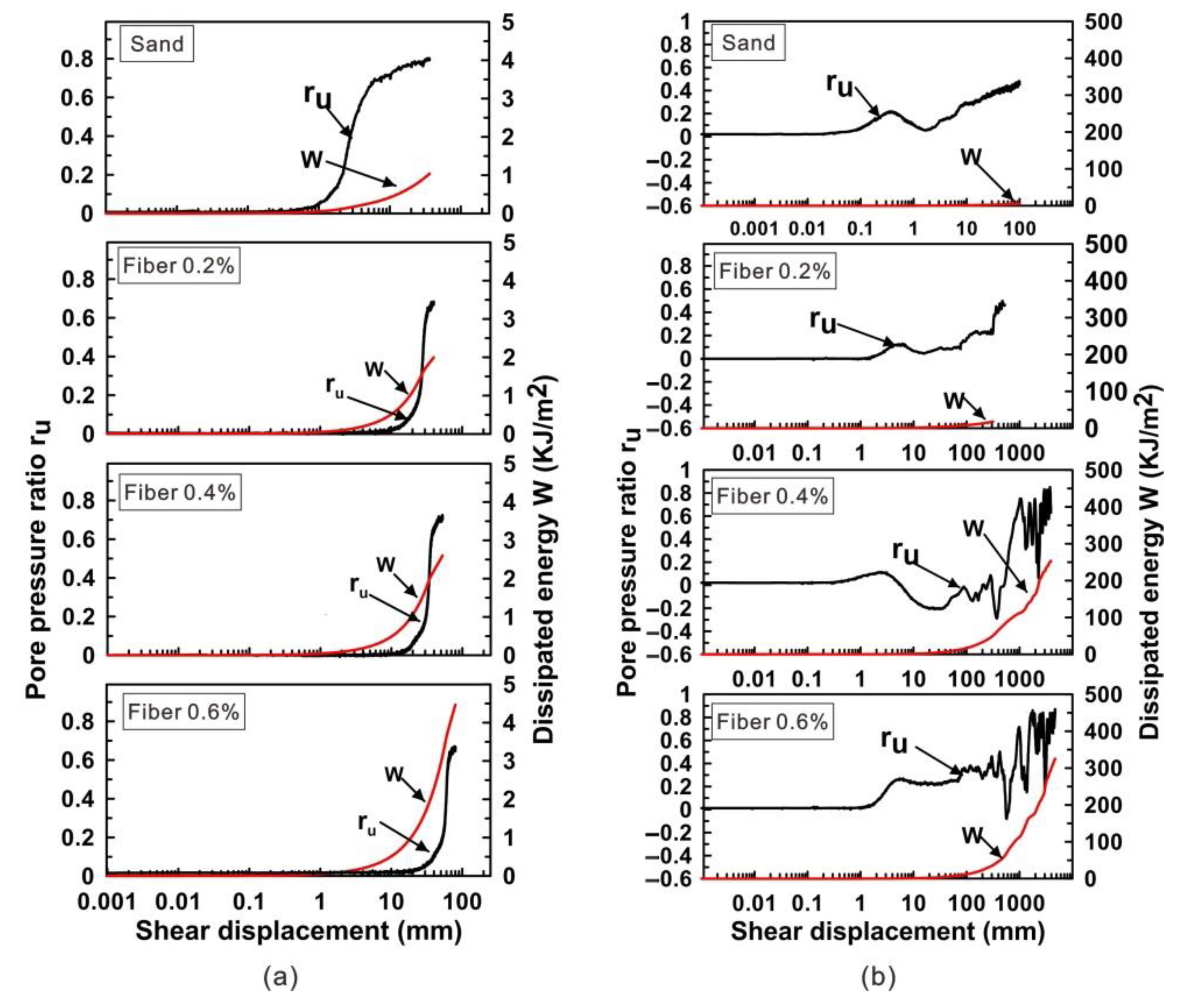
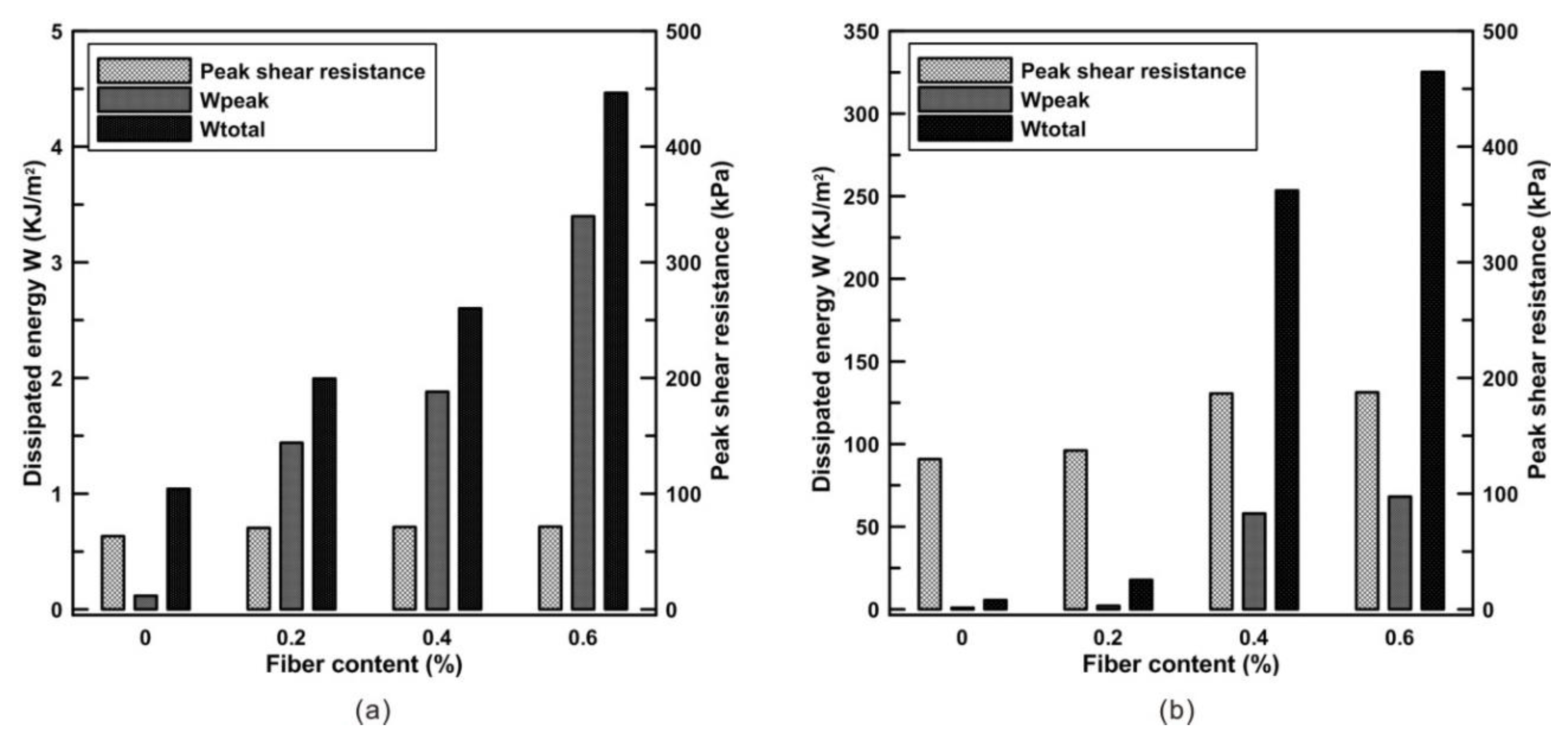
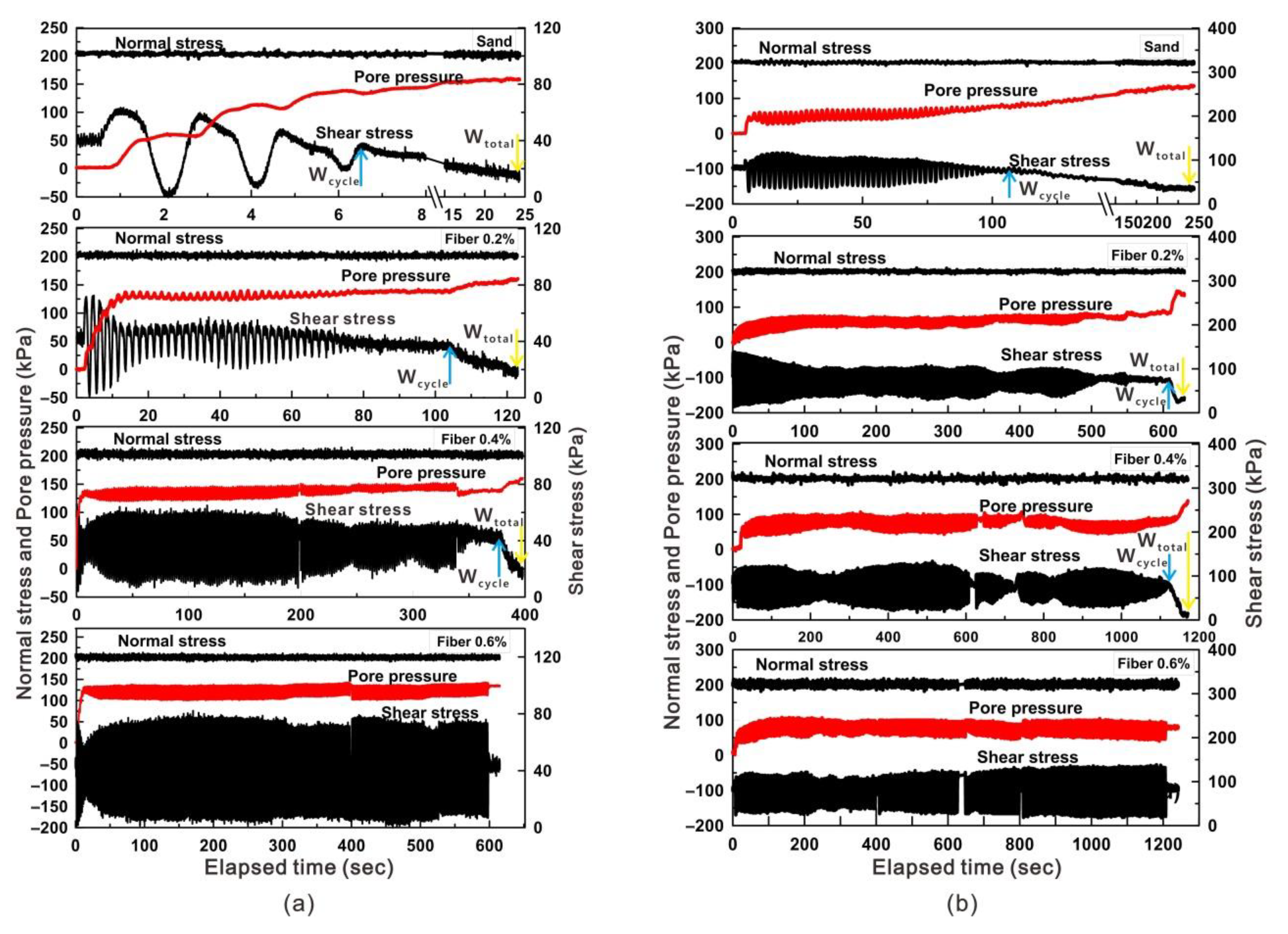
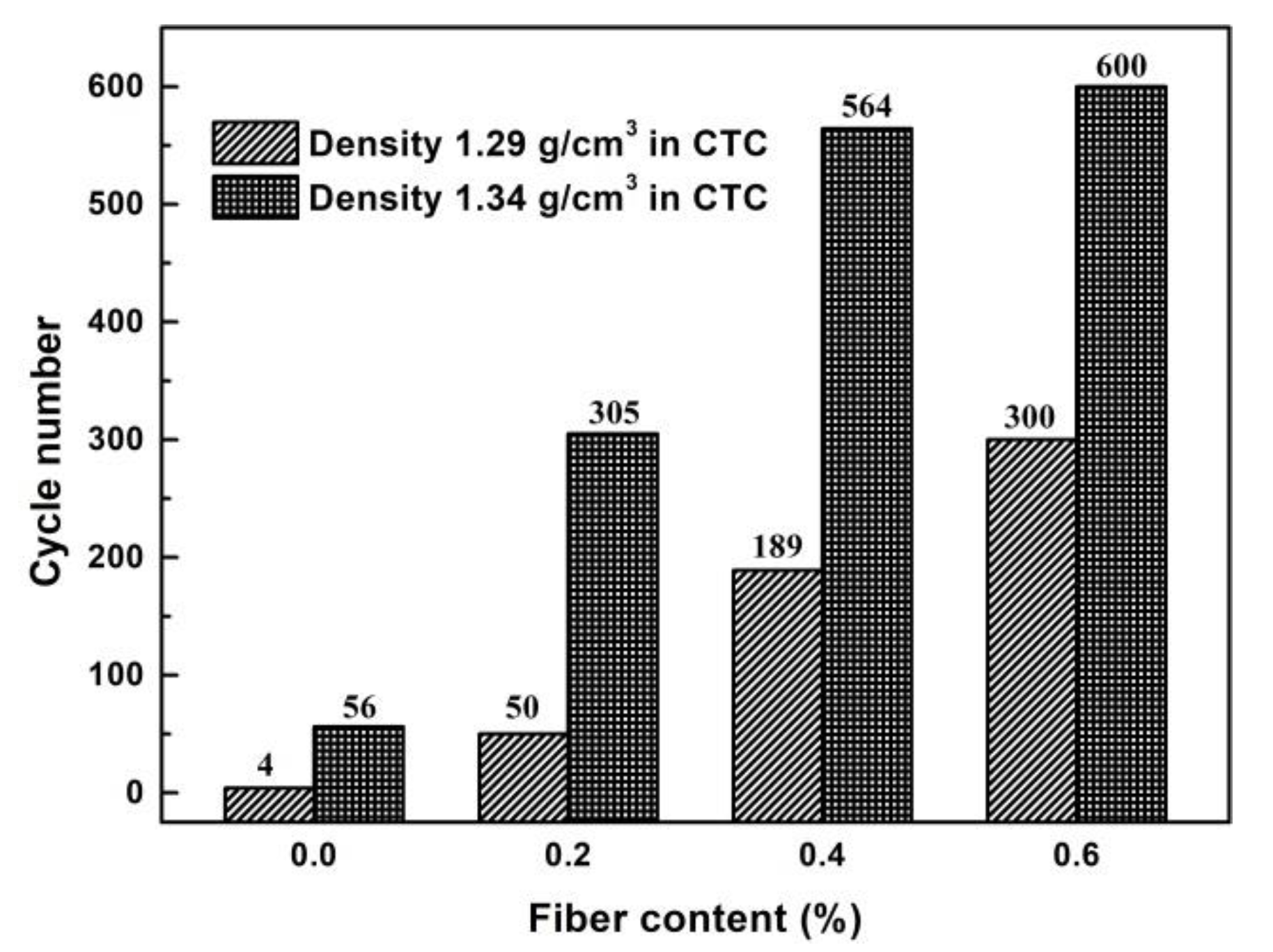

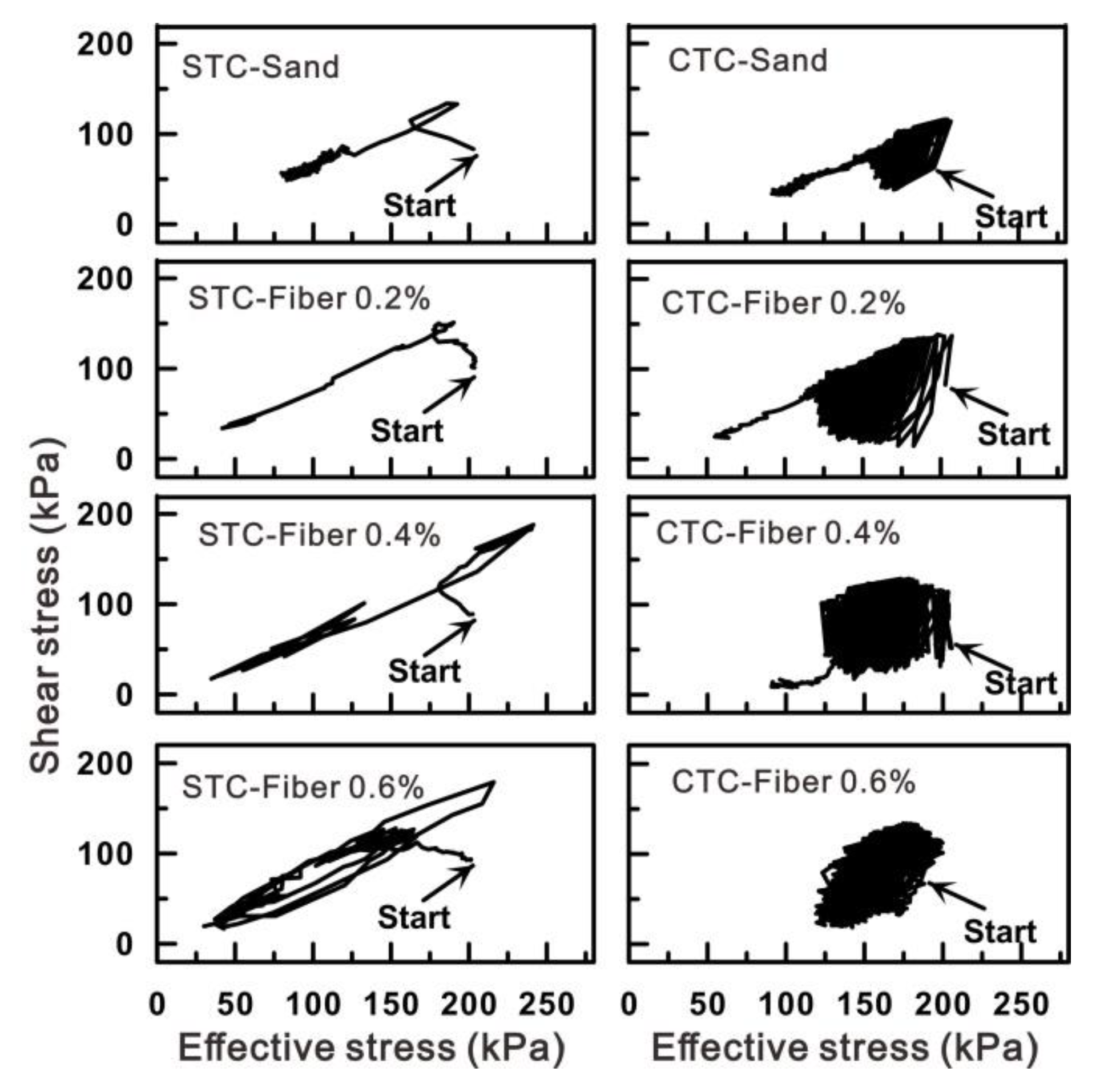
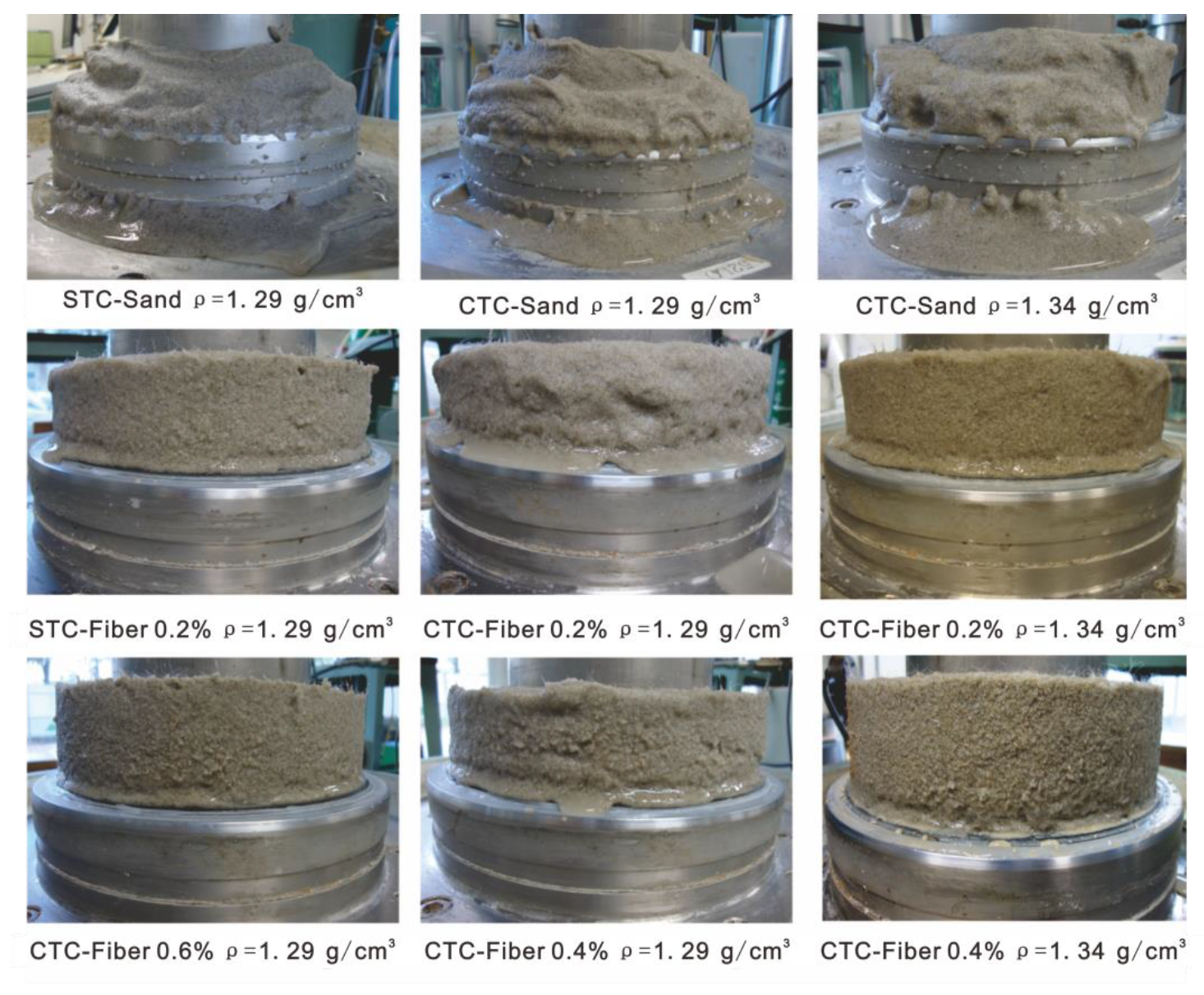
| Test | Pf (%) | e01 | Ρdra2 (g/cm3) | Dr3 (%) | BD4 | σcon5 (kPa) | τstatic6 (kPa) | τcyclic7 (kPa) | f8 (Hz) | Shear Method |
|---|---|---|---|---|---|---|---|---|---|---|
| T1 | 0 | 1.05 | 1.29 | 14.85 | 0.98 | 200 | 40 | / | / | STC-1 |
| T2 | 0.2 | 1.05 | 1.29 | 14.85 | 0.98 | 200 | 40 | / | / | STC-2 |
| T3 | 0.4 | 1.05 | 1.29 | 14.85 | 0.97 | 200 | 40 | / | / | STC-3 |
| T4 | 0.6 | 1.05 | 1.29 | 14.85 | 0.96 | 200 | 40 | / | / | STC-4 |
| T5 | 0 | 0.97 | 1.34 | 32.16 | 0.97 | 200 | 80 | / | / | STC-5 |
| T6 | 0.2 | 0.97 | 1.34 | 32.16 | 0.98 | 200 | 80 | / | / | STC-6 |
| T7 | 0.4 | 0.97 | 1.34 | 32.16 | 0.97 | 200 | 80 | / | / | STC-7 |
| T8 | 0.6 | 0.97 | 1.34 | 32.16 | 0.96 | 200 | 80 | / | / | STC-8 |
| T9 | 0 | 1.05 | 1.29 | 14.85 | 0.98 | 200 | 40 | 60 | 0.5 | CTC-1 |
| T10 | 0.2 | 1.05 | 1.29 | 14.85 | 0.98 | 200 | 40 | 60 | 0.5 | CTC-2 |
| T11 | 0.4 | 1.05 | 1.29 | 14.85 | 0.97 | 200 | 40 | 60 | 0.5 | CTC-3 |
| T12 | 0.6 | 1.05 | 1.29 | 14.85 | 0.96 | 200 | 40 | 60 | 0.5 | CTC-4 |
| T13 | 0 | 0.97 | 1.34 | 32.16 | 0.97 | 200 | 80 | 60 | 0.5 | CTC-5 |
| T14 | 0.2 | 0.97 | 1.34 | 32.16 | 0.98 | 200 | 80 | 60 | 0.5 | CTC-6 |
| T15 | 0.4 | 0.97 | 1.34 | 32.16 | 0.97 | 200 | 80 | 60 | 0.5 | CTC-7 |
| T16 | 0.6 | 0.97 | 1.34 | 32.16 | 0.96 | 200 | 80 | 60 | 0.5 | CTC-8 |
| Test | Pf (%) | ρdra (g/cm3) | τpeak1 (kpa) | ru,peak2 | lpeak3 (mm) | Wpeak4 (J/m2) | ru,top5 | ltotal6 (mm) | Wtotal7 (J/m2) |
|---|---|---|---|---|---|---|---|---|---|
| STC-1 | 0.00 | 1.29 | 63.23 | 0.19 | 2.08 | 117.46 | 0.81 | 36.45 | 1040.89 |
| STC-2 | 0.20 | 1.29 | 70.40 | 0.22 | 25.36 | 1440.19 | 0.72 | 39.75 | 1995.13 |
| STC-3 | 0.40 | 1.29 | 71.20 | 0.29 | 32.83 | 1881.33 | 0.71 | 52.53 | 2601.52 |
| STC-4 | 0.60 | 1.29 | 71.45 | 0.27 | 56.62 | 3397.90 | 0.67 | 79.98 | 4465.08 |
| STC-5 | 0.00 | 1.34 | 129.78 | 0.12 | 8.92 | 954.45 | 0.51 | 99.63 | 5618.07 |
| STC-6 | 0.20 | 1.34 | 137.28 | 0.05 | 16.69 | 2087.41 | 0.50 | 315.41 | 17,756.63 |
| STC-7 | 0.40 | 1.34 | 186.57 | −0.27 | 358.54 | 57,977.46 | 0.85 | 3920.68 | 253,479.20 |
| STC-8 | 0.60 | 1.34 | 187.57 | −0.07 | 563.70 | 68,227.40 | 0.85 | 4705.94 | 325,217.30 |
| Test | Pf (%) | ρdra (g/cm3) | N1 | Lcycle2 (mm) | Wcycle3 (J/m2) | ltotal (mm) | Wtotal (J/m2) |
|---|---|---|---|---|---|---|---|
| CTC-1 | 0.00 | 1.29 | 3.00 | 14.71 | 581.20 | 78.17 | 2176.74 |
| CTC-2 | 0.20 | 1.29 | 50.00 | 280.23 | 11,767.08 | 459.96 | 16,188.95 |
| CTC-3 | 0.40 | 1.29 | 189.00 | 561.72 | 29,386.18 | 1066.55 | 46,866.21 |
| CTC-4 | 0.60 | 1.29 | 300.00↑ | / | / | / | / |
| CTC-5 | 0.00 | 1.34 | 54.00 | 128.97 | 12,103.65 | 875.02 | 71,749.19 |
| CTC-6 | 0.20 | 1.34 | 301.00 | 719.56 | 64,148.68 | 1435.22 | 86,517.91 |
| CTC-7 | 0.40 | 1.34 | 558.00 | 890.21 | 87,849.17 | 1674.13 | 105,928.90 |
| CTC-8 | 0.60 | 1.34 | 600.00↑ | / | / | / | / |
© 2019 by the authors. Licensee MDPI, Basel, Switzerland. This article is an open access article distributed under the terms and conditions of the Creative Commons Attribution (CC BY) license (http://creativecommons.org/licenses/by/4.0/).
Share and Cite
Bai, Y.; Liu, J.; Song, Z.; Bu, F.; Qi, C.; Qian, W. Effects of Polypropylene Fiber on the Liquefaction Resistance of Saturated Sand in Ring Shear Tests. Appl. Sci. 2019, 9, 4078. https://doi.org/10.3390/app9194078
Bai Y, Liu J, Song Z, Bu F, Qi C, Qian W. Effects of Polypropylene Fiber on the Liquefaction Resistance of Saturated Sand in Ring Shear Tests. Applied Sciences. 2019; 9(19):4078. https://doi.org/10.3390/app9194078
Chicago/Turabian StyleBai, Yuxia, Jin Liu, Zezhuo Song, Fan Bu, Changqing Qi, and Wei Qian. 2019. "Effects of Polypropylene Fiber on the Liquefaction Resistance of Saturated Sand in Ring Shear Tests" Applied Sciences 9, no. 19: 4078. https://doi.org/10.3390/app9194078
APA StyleBai, Y., Liu, J., Song, Z., Bu, F., Qi, C., & Qian, W. (2019). Effects of Polypropylene Fiber on the Liquefaction Resistance of Saturated Sand in Ring Shear Tests. Applied Sciences, 9(19), 4078. https://doi.org/10.3390/app9194078






